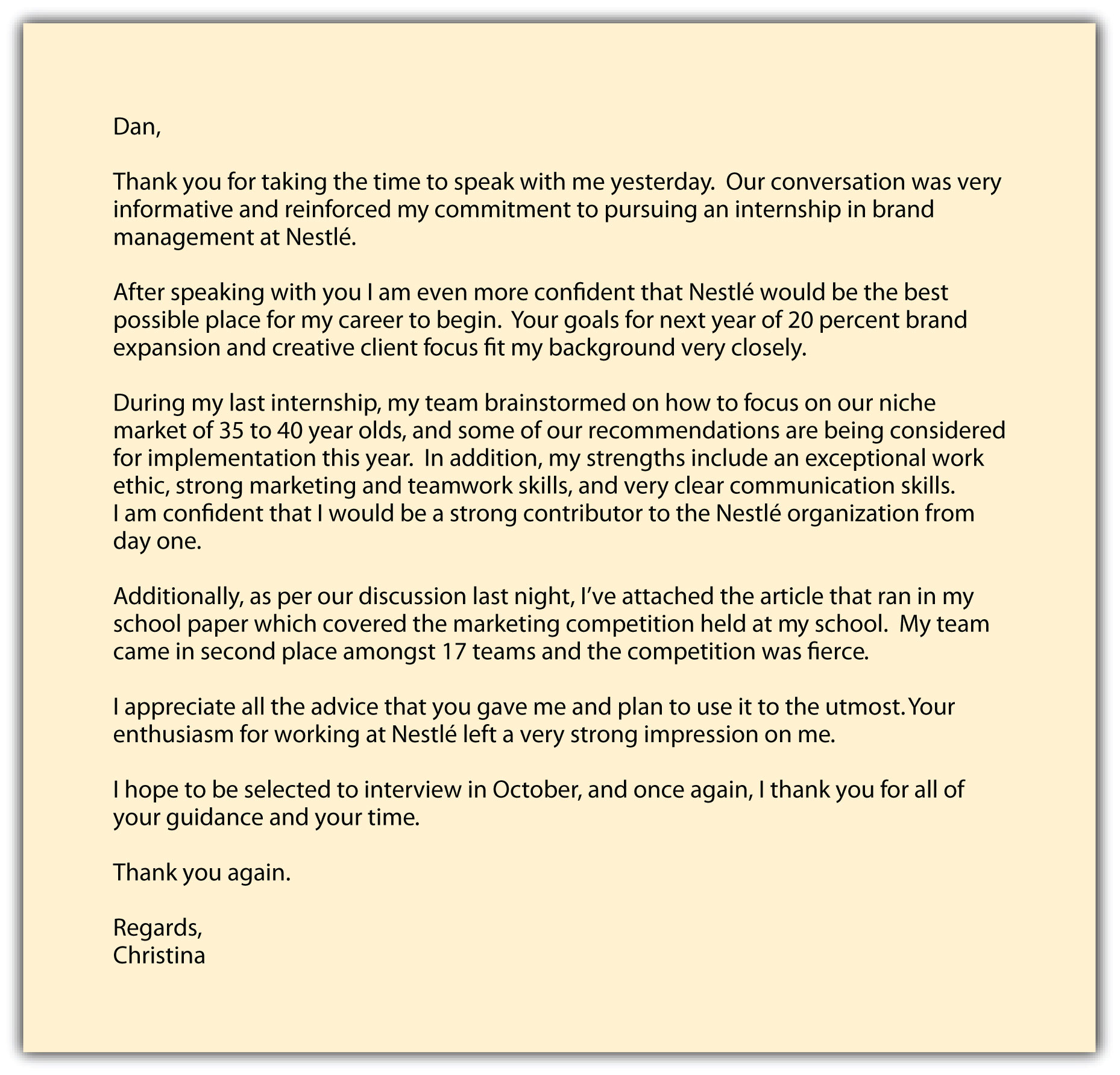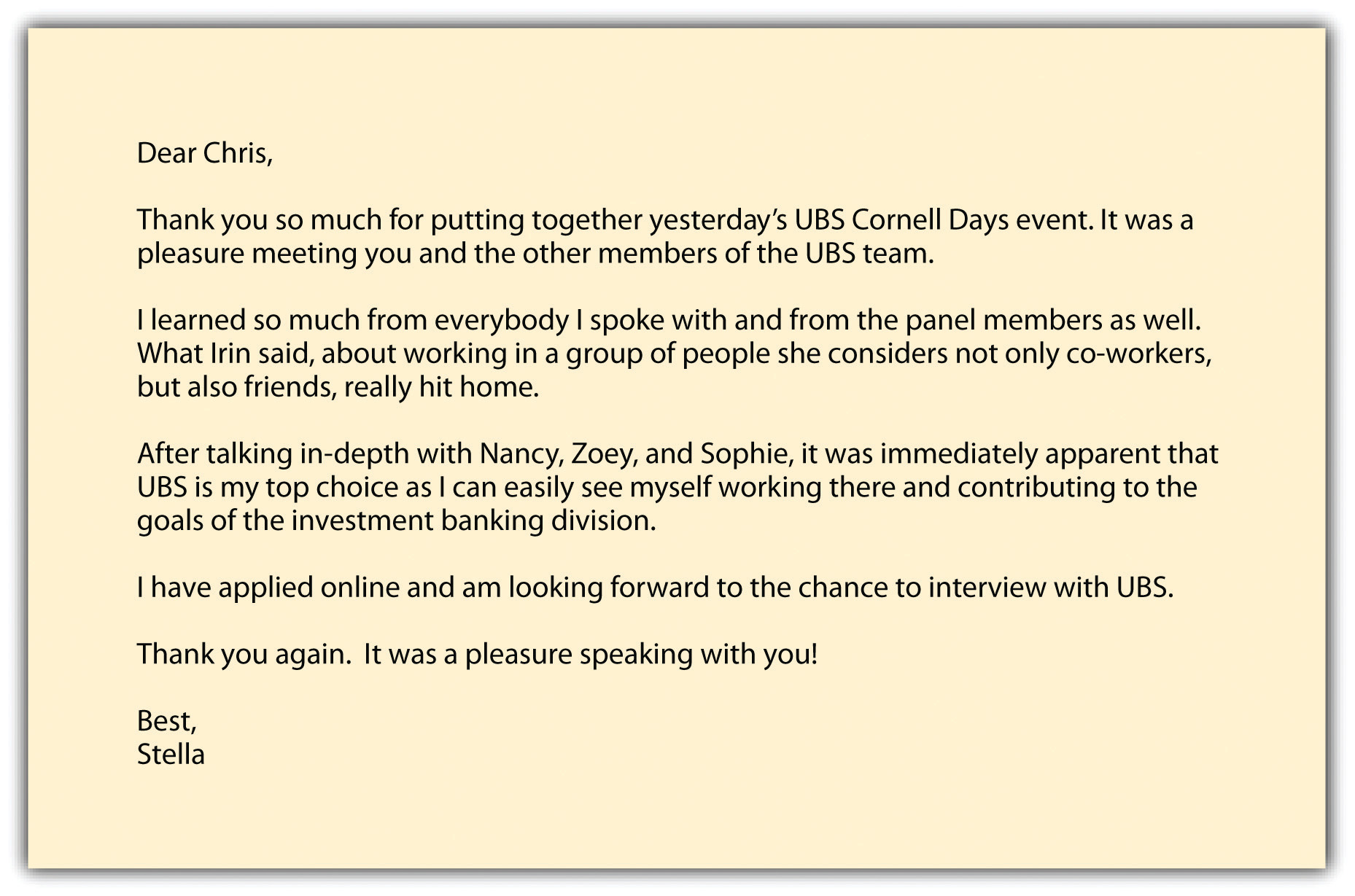8.2: The Four Stages of Networking
Caroline Ceniza-Levine and Connie Thanasoulis-Cerrachio
Networking consists of four stages, and the sequential order of the four stages is extremely important:
- Research
- The approach
- The follow-up
- The request
We all know individuals who call us only when they need something. They use only two of the four steps: they go from the approach right to the request. We know how we feel when this happens. When these people contact us, we no doubt say to ourselves, “I wonder what they want now.” To avoid this annoying behavior, you must follow the four steps sequentially. Let us review each one in the order they should be used.
Research
Research enables you to identify key things and key people with whom you should be networking. In a job search, you should aim your research to answer the following questions:
- What details are available about the company of interest?
- What specific departments exist within the company?
- Who are the individuals who run those departments (the decision-makers)?
- Does this company recruit on campus?
- Does HR lead the company’s recruiting efforts, or do the hiring managers find their own talent (for the most part)?
- What is the profitability of each department?
- What companies compete against the main company and against the specific departments (they might be different)?
- What are the top products and services produced?
- What are the goals of the company or the department?
- What recent challenges and trends are they experiencing?
Once you identify these items, research everything about them through company websites, Google, LinkedIn, and the people in your network. The more information you gather, the more knowledgeable you will be about your job search, and the more likely you will impress those with whom you meet and network.
The Approach
Once you have identified the individuals with whom you would like to network or contact, think about how you would like to contact them. Great care should be taken with this step because first impressions matter. Things to consider include the following:
-
Do you know anyone who can make a warm introduction? Cold contacts are clearly not as effective as an introduction from someone who knows both parties. If you are fortunate enough to have such a contact, approach them to make the connection. Never ask for a job. Instead, ask that they make an introduction. People you already know can make introductions:
- Friends and family
- Current or past employees of the company (this includes classmates who have interned at companies of interest)
- Peers at school
- Career services
- Other school contacts, including professors, administrators, and so on
- If you must make a cold contact, your research can be used to impress. In a cover letter, you may write intelligently and compellingly about how you can be instrumental in the company because you can do x, y, or z. Be specific about your knowledge of the company, the departments, and the company’s competitors. Know why another company is challenging them, or why they are clearly the industry leader with no close second.
Reconnect with Old Contacts
If you have great contacts, but have not kept in touch with them, you can use different ways to reconnect, but take care to not offend. The first time you reconnect, it cannot be about your job search. You cannot ask for anything the first time, except how the other person is doing. The point of reconnecting is to reestablish the relationship. The other person is the focus and by listening to them and being interested, you actually help yourself because you will learn about what is going on in the market and what people care about, and you can act on this later.
This is why maintaining your network is so critical when you do not need anything. It takes the time pressure off you to accomplish anything. If, however, you have waited until you are in need to work on your network, then you must discipline yourself to make those early contacts about your network and not about yourself. One good exercise is to take three to five contacts per day and just say hello. This gets you in the habit of regularly reaching out to your network so that when you actually have a question to ask or even a favor, the request isn’t the only time you have reached out.
When using LinkedIn, remind people how you know each other. Do not use those template connection invitations. Compose a personal message about where you met, when you last spoke, or something else that shows genuine interest. Add an updated and professional-looking picture of yourself so that old connections who may have forgotten your name can recognize you visually.
The Follow-Up
A networking paradox, a seemingly contradictory statement that may nonetheless be true, is that you cannot get a job without networking, but the biggest networking pet peeve is when someone asks for a job. Remember that no one wants to be contacted only in times of need. That is what gives networking a bad reputation.
Once you have made the contact, the very next step is to follow up and maintain the networking contact. Immediately after meeting someone, following either a marketing event of some kind, a networking meeting, or an interview, you should send that person an e-mail that mentions that you were happy to see or meet them, references something you discussed (to at the very least remind them of your conversation), and asks for nothing in return.
Recruiters and hiring managers appreciate e-mails that reiterate interest or share an item that may be of interest to them, but what is not appreciated is requiring that they get back regarding a date or detail of some kind. Avoid it if at all possible. The best way to build a solid network is to contact people when you do not need anything. Even if you are a job seeker and are networking to jump-start your search, you do not want your first contact (or even your second) to be a request for help. Instead, maintain (or restart) your network by reaching out to people regularly—without asking for anything.
If you plan to add someone to your network for the long term, you should follow up with that person several times a year. Asking for help or just talking about yourself doesn’t count. Follow up in a way that focuses on them and what you can do for them, not the other way around. Focus on giving away—not selling. Here are some creative ways to reach out:
- Say thank you: Thank them for their time in meeting with you, and for the information they shared. Add something you discussed to the thank-you note to support the fact that you were listening and comprehending. Set the stage for future networking contact.
- Give a results update: If someone gave you advice, let them know what you did with it. Perhaps someone made a connection that resulted in another connection. Keep them updated and thank them again for the connection.
- Spread holiday cheer: Send holiday cards, and include some information about yourself to keep people updated. Remember to note information you receive in return (e.g., changes of address, changes of employment). Christmas, Hanukkah, New Year’s Day, Easter, the Fourth of July, Passover, Memorial Day, and Thanksgiving are great times to keep in touch, but you might even use the arrival of spring as a reason to reach out.
- Announce a life change: You might announce the end of the school year, entrance to an internship, entry to a graduate degree program, a promotion, or just an e-mail change. When you send out announcements, include news about other areas of your life. Always be upbeat. Job seekers can let their network know they are looking in specific industries, but should not immediately ask for help. For job seekers who have already announced they are looking, consider a follow-up contact letting people know where you are in your search.
- Offer an interesting article: Pick something about their industry and company, and it shows you are on top of news that matters to them. This works well for professional contacts, with whom you may not be on a familiar enough basis for a holiday card or personal announcement. An insightful article lets the contact know you are thinking of them and you understand what’s important in their industry.
- Introduce a new contact: When you introduce people to your network, not only do you expand the contacts of the person you introduce, but you also get an opportunity to catch up with your network. Like sending an interesting article, an interesting referral lets the contact know you are knowledgeable about their needs and willing to help.
- Simply say hello: Sometimes a person just pops into your head. Maybe they resemble someone on TV. Maybe you heard a joke they would enjoy. Follow your instinct and call or e-mail to say hello. It is always nice to know people are thinking of you.
- Offer congratulations: Did they make one of those business magazine top lists (e.g., Most Innovative, Most Admired, Best Places to Work)? If you hear good news about someone or their company, point it out.
- Make a recommendation: If you read a good book, try a good restaurant, and so forth, pass that on. (Make sure to keep it professional because your referrals are always a reflection of you.)
Use these nine methods, timed six to seven weeks apart, and you have almost a year of follow-up. Now you have no excuse not to maintain your network.
Figure 8.1 and Figure 8.2 are examples of a follow-up note after a networking meeting.
Figure 8.1 Example Follow-Up Note 1

Figure 8.2 Example Follow-Up Note 2

The Request
Only when you have completed the first three steps should you make a request. The quality of your network depends on following this checklist. It is tempting to jump from step 2 (the approach) to step 4 (the request), but you do so at the risk of not building a quality network on which you can rely for your professional success.
Exercise
Test your knowledge of the Four Steps of Networking below by dragging and dropping the networking activities into their appropriate stage.

